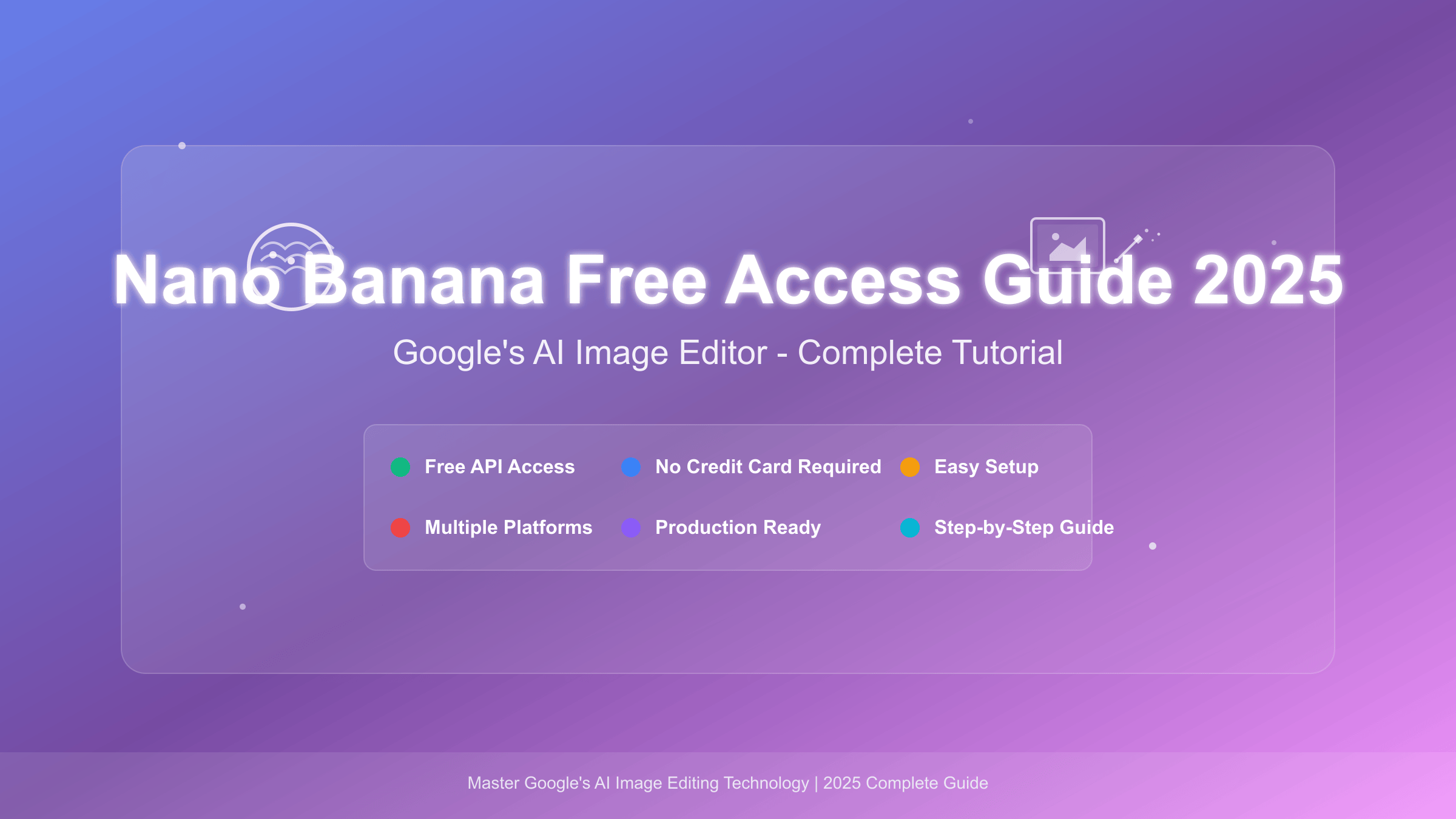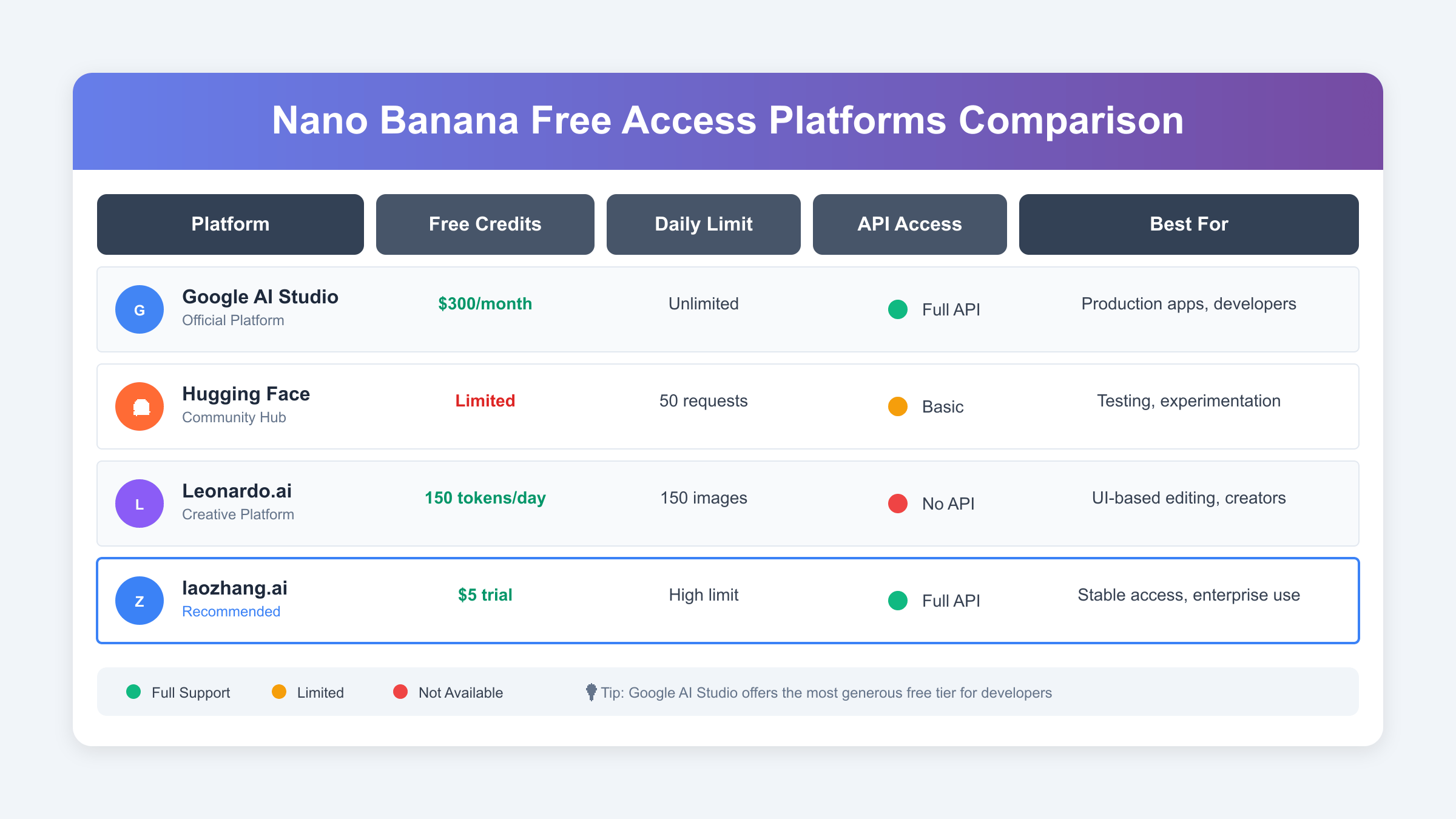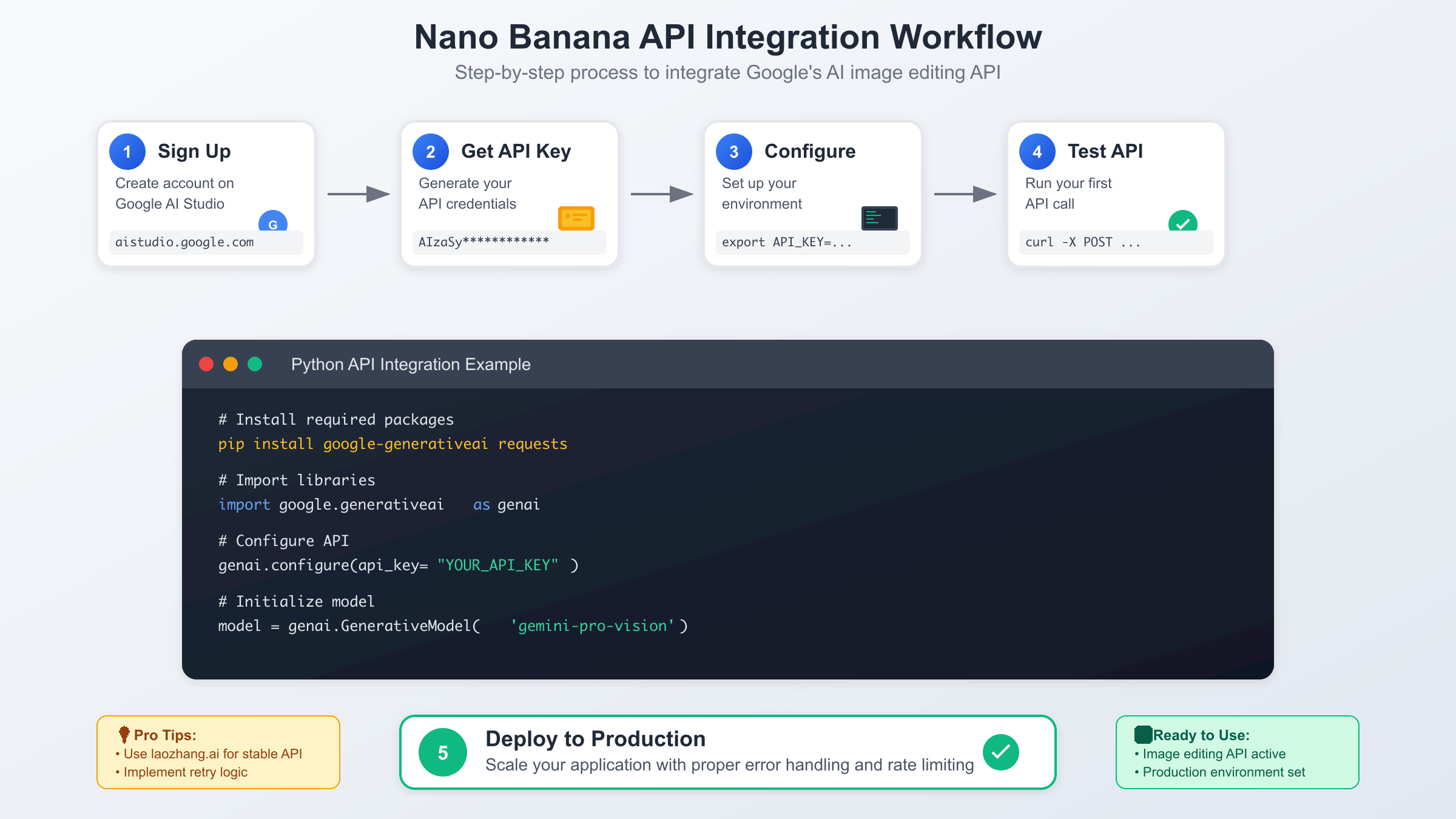Nano Banana, Google’s Gemini 2.5 Flash Image model, offers powerful image generation and editing capabilities for free through multiple platforms. Released in August 2025, this state-of-the-art AI model enables developers and creators to generate high-quality images using natural language prompts without immediate costs.

What is Nano Banana (Gemini 2.5 Flash Image)?
Nano Banana is the community nickname for Google’s Gemini 2.5 Flash Image model, officially launched on August 26, 2025. This advanced AI system represents Google’s latest breakthrough in image generation technology, offering capabilities that extend far beyond simple text-to-image conversion.
The model operates on a token-based pricing system at $30 per million output tokens, with each generated image consuming approximately 1,290 tokens (roughly $0.039 per image). For detailed cost analysis and pricing comparisons, see our complete Gemini 2.5 Flash Image API pricing guide. However, multiple platforms provide free access tiers that allow extensive experimentation without upfront costs.
Key technical specifications include support for multiple input images (up to 3), conversational image editing, character consistency maintenance, and integration of Gemini’s world knowledge for contextually accurate image generation. The model automatically includes SynthID watermarking for AI-generated content identification.
Understanding Nano Banana’s Core Capabilities
Gemini 2.5 Flash Image excels in several key areas that distinguish it from other AI image models. The system supports advanced image editing through natural language commands, enabling users to make specific modifications without complex photo editing software.
Multi-image composition represents another significant strength. Users can blend multiple source images into cohesive final outputs while maintaining visual consistency. This capability proves particularly valuable for creative projects requiring specific character appearances or design elements across multiple generated images.
The model’s integration with Gemini’s knowledge base allows for contextually aware image generation. For example, requesting “a Victorian-era scientist in their laboratory” will produce historically accurate details including appropriate clothing, equipment, and architectural elements from that period.
Method 1: Free Access Through Google AI Studio
Google AI Studio provides the most direct free access to Nano Banana’s capabilities. This official platform requires only a Google account and offers comprehensive image generation tools without immediate payment requirements.
To begin using Google AI Studio, navigate to aistudio.google.com and sign in with your Google account. Select “Create” from the main interface, then choose “Image” to access the Gemini 2.5 Flash Image playground. The interface presents a clean prompt input field where you can describe your desired image using natural language.
The platform includes preset templates for common use cases, allowing beginners to understand effective prompting techniques. Templates cover scenarios like “product photography,” “character design,” and “architectural visualization,” each demonstrating optimal prompt structure for specific image types.
Advanced users can leverage the conversational editing features by uploading existing images and requesting specific modifications. For example, uploading a landscape photo and prompting “add a futuristic city skyline in the background” will seamlessly integrate the new elements while maintaining the original image’s lighting and perspective.
Method 2: Leonardo.AI Free Tier Integration
Leonardo.AI offers Nano Banana access through their platform’s free tier, providing 150 tokens daily to registered users. Since each image generation costs 40 tokens, free users can create approximately 3-4 high-quality images per day without subscription fees.

The Leonardo.AI implementation includes additional features like batch generation and style presets specifically optimized for Nano Banana’s capabilities. Users can select from predefined artistic styles, photographic approaches, or technical illustration formats before generating images.
Account registration requires only an email address, and the platform provides immediate access to image generation tools. The token system refreshes daily at midnight UTC, ensuring consistent access for regular users. Premium features like higher resolution outputs and priority processing remain available through paid subscriptions.
Method 3: Direct API Integration with Free Quotas
Developers can access Nano Banana directly through the Gemini API using free quota allocations. Google provides substantial free tier access for API testing and development purposes, typically including several hundred image generations monthly.
API integration requires obtaining an API key from Google AI Studio’s API section. The process involves creating a new project, enabling the Gemini API, and generating credentials for programmatic access. For detailed instructions, see our complete guide to getting Gemini API keys. The official model identifier for Nano Banana is “gemini-2.5-flash-image-preview”.
Python implementation follows standard REST API patterns with the Google generative AI library. Basic setup requires installing the google-generativeai package and configuring authentication with your API key. Error handling becomes crucial for production applications, as quota limits can interrupt image generation workflows.
Setting Up Nano Banana API Access
Implementing Nano Banana through the Gemini API requires careful attention to authentication, error handling, and quota management. The following code examples demonstrate proper integration techniques for Python applications.

Begin by installing the required dependencies and configuring your development environment for Gemini API access:
pip install google-generativeai pillow requestsBasic image generation implementation demonstrates the core functionality available through the API:
import google.generativeai as genai
import os
from PIL import Image
import io
# Configure API key
genai.configure(api_key=os.getenv('GEMINI_API_KEY'))
# Initialize the model
model = genai.GenerativeModel('gemini-2.5-flash-image-preview')
def generate_image(prompt, output_path=None):
"""
Generate image using Nano Banana model
Args:
prompt (str): Text description for image generation
output_path (str): Optional path to save generated image
Returns:
PIL.Image: Generated image object
"""
try:
response = model.generate_content([prompt])
# Extract image data from response
if response.parts:
image_data = response.parts[0].inline_data.data
image = Image.open(io.BytesIO(image_data))
if output_path:
image.save(output_path)
print(f"Image saved to {output_path}")
return image
except Exception as e:
print(f"Error generating image: {e}")
return None
# Example usage
prompt = "A modern workspace with AI development tools, clean lighting, professional atmosphere"
generated_image = generate_image(prompt, "workspace.png")Advanced Image Editing with Nano Banana
Nano Banana’s conversational editing capabilities enable sophisticated image modifications through natural language instructions. This feature distinguishes the model from traditional image generators by supporting iterative refinements and specific adjustments.
Image editing workflows typically begin with uploading a base image, then applying modifications through descriptive prompts. The model maintains consistency with the original image while implementing requested changes, preserving important elements like lighting, perspective, and overall composition.
Advanced editing example demonstrates multi-step image refinement:
def edit_image_iteratively(base_image_path, edit_instructions):
"""
Apply multiple edits to a base image using conversational prompts
Args:
base_image_path (str): Path to the original image
edit_instructions (list): List of editing prompts to apply
Returns:
PIL.Image: Final edited image
"""
# Load base image
with open(base_image_path, 'rb') as img_file:
base_image = img_file.read()
current_image = base_image
for instruction in edit_instructions:
try:
# Create prompt combining image and instruction
prompt = f"Edit this image: {instruction}"
response = model.generate_content([
prompt,
{"mime_type": "image/png", "data": current_image}
])
if response.parts:
current_image = response.parts[0].inline_data.data
print(f"Applied edit: {instruction}")
except Exception as e:
print(f"Error applying edit '{instruction}': {e}")
continue
# Convert final result to PIL Image
final_image = Image.open(io.BytesIO(current_image))
return final_image
# Example usage
edits = [
"Enhance the lighting to be more dramatic",
"Add a subtle blue color grading",
"Increase the sharpness of foreground elements"
]
edited_image = edit_image_iteratively("original.png", edits)Optimizing Prompts for Better Results
Effective prompt engineering significantly impacts the quality and accuracy of Nano Banana’s output. The model responds best to specific, detailed descriptions that include context, style preferences, and technical requirements.
Successful prompts typically follow a structured format: subject description, environment or setting, style specifications, lighting conditions, and any technical requirements like aspect ratio or composition preferences. This systematic approach ensures consistent results across multiple generations.
Technical photography language proves particularly effective for achieving professional-quality outputs. Terms like “shallow depth of field,” “golden hour lighting,” “rule of thirds composition,” and “high dynamic range” communicate specific visual qualities to the model.
Character consistency across multiple images requires careful prompt construction. Including detailed character descriptions, consistent styling elements, and specific pose or expression instructions helps maintain visual continuity for projects requiring multiple related images.
Managing API Quotas and Rate Limits
Effective quota management ensures uninterrupted access to Nano Banana’s capabilities while avoiding service limitations. The Gemini API implements rate limiting to prevent abuse and ensure fair access across all users.
Free tier quotas typically reset monthly and include generous allowances for development and testing purposes. Production applications should implement proper monitoring to track usage patterns and prevent quota exhaustion during critical operations. Learn more about Gemini API rate limits and quota management.
Rate limiting implementation requires exponential backoff strategies for handling temporary service limitations:
import time
import random
def generate_with_retry(prompt, max_retries=3):
"""
Generate image with retry logic for rate limiting
Args:
prompt (str): Image generation prompt
max_retries (int): Maximum retry attempts
Returns:
PIL.Image or None: Generated image or None if failed
"""
for attempt in range(max_retries):
try:
response = model.generate_content([prompt])
if response.parts:
image_data = response.parts[0].inline_data.data
return Image.open(io.BytesIO(image_data))
except Exception as e:
if "rate limit" in str(e).lower() and attempt < max_retries - 1:
# Exponential backoff with jitter
wait_time = (2 ** attempt) + random.uniform(0, 1)
print(f"Rate limited, waiting {wait_time:.1f} seconds...")
time.sleep(wait_time)
continue
else:
print(f"Failed after {attempt + 1} attempts: {e}")
break
return NoneTroubleshooting Common Issues
Authentication errors represent the most frequent obstacle when implementing Nano Banana API access. Ensure your API key is correctly configured and has appropriate permissions for the Gemini API. Invalid or expired keys will result in 401 unauthorized responses.
Image generation failures often stem from prompt complexity or content policy violations. The model filters inappropriate content requests and may refuse to generate images containing violence, explicit material, or copyrighted characters. Revising prompts to focus on general concepts rather than specific brands or individuals typically resolves these issues.
Quota exhaustion becomes problematic for applications with high usage patterns. Implementing usage monitoring and graceful degradation ensures your application continues functioning when approaching quota limits. Consider implementing local caching for frequently requested images to reduce API calls.
Network connectivity issues can interrupt long-running image generation processes. Implementing proper timeout handling and retry logic prevents application failures during temporary network problems. The API typically responds within 30-60 seconds for complex image generation requests.
Comparing Free Access Methods
Each free access method offers distinct advantages depending on your specific use case and technical requirements. Google AI Studio provides the most straightforward approach for individual creators and researchers who need immediate access without development overhead.
Leonardo.AI's platform excels for users requiring additional creative tools and batch processing capabilities. The integrated workflow includes style presets, image enhancement tools, and collaborative features that extend beyond basic image generation.
Direct API integration suits developers building applications that incorporate image generation as a core feature. This approach offers maximum flexibility but requires technical implementation and ongoing maintenance considerations. To understand how Nano Banana compares with other image generation APIs, check our detailed comparison between Gemini 2.5 Flash and GPT-4 image APIs.
For production applications requiring guaranteed availability and higher throughput, transitioning to paid services becomes necessary. Platforms like laozhang.ai provide enterprise-grade API access with enhanced reliability, faster response times, and dedicated support for critical applications.
When to Consider Paid Alternatives
While free access methods provide excellent opportunities for experimentation and light usage, certain scenarios benefit from paid service alternatives. High-volume applications, commercial projects, and time-sensitive workflows often require guaranteed availability and enhanced performance.
Free tier limitations include daily usage quotas, potentially slower response times during peak periods, and limited customer support. These constraints can impact business-critical applications that depend on consistent image generation capabilities.
Professional API services like laozhang.ai offer several advantages over free access methods. Enhanced infrastructure ensures reliable performance even during high-demand periods, while dedicated customer support provides assistance for complex implementation challenges. For additional free API options, explore our guide on accessing Gemini 2.5 Pro API for free.
Enterprise features include custom model fine-tuning, enhanced security measures, and SLA guarantees that protect business operations. For organizations integrating AI image generation into customer-facing applications, these professional services provide the reliability and support necessary for successful deployment.
Best Practices for Production Use
Transitioning from free experimentation to production implementation requires careful consideration of performance, reliability, and scalability factors. Proper error handling, caching strategies, and monitoring become essential for maintaining application stability.
Implement comprehensive logging to track API usage patterns, error rates, and performance metrics. This data helps optimize prompt strategies and identify potential issues before they impact users. Consider using structured logging formats that facilitate analysis and troubleshooting.
Image caching significantly reduces API calls and improves application responsiveness. Implement both local and distributed caching strategies to store frequently requested images. Include cache invalidation mechanisms to ensure content freshness when updating image generation parameters.
User experience optimization includes providing clear feedback during image generation processes, implementing progressive loading for better perceived performance, and offering meaningful error messages when generation fails. Consider implementing queue systems for handling multiple concurrent image generation requests.
Future Developments and Updates
Google continues advancing the Gemini 2.5 Flash Image model with regular updates and feature enhancements. Recent developments include improved prompt understanding, faster generation speeds, and enhanced image quality across various content types.
Upcoming features may include extended input image support, advanced style transfer capabilities, and integration with other Google AI services. Staying informed about these developments helps optimize your implementation and take advantage of new capabilities as they become available.
Community resources like the Google AI Developer documentation, GitHub repositories, and developer forums provide valuable insights into best practices and emerging techniques. Participating in these communities helps discover optimization strategies and troubleshoot implementation challenges.
The AI image generation landscape continues evolving rapidly, with new models and capabilities emerging regularly. Maintaining flexibility in your implementation architecture allows for easier integration of future enhancements and alternative services as they become available.
Conclusion
Nano Banana (Gemini 2.5 Flash Image) offers powerful image generation capabilities through multiple free access methods, making advanced AI imagery accessible to developers, creators, and researchers. Whether using Google AI Studio's user-friendly interface, Leonardo.AI's creative platform, or direct API integration, users can explore sophisticated image generation without immediate financial commitment.
Success with Nano Banana depends on understanding effective prompting techniques, implementing proper error handling, and choosing the appropriate access method for your specific needs. Free access methods provide excellent opportunities for learning and experimentation, while paid alternatives like laozhang.ai offer the reliability and performance required for production applications. For broader insights into AI image generation, explore our comprehensive guide on ChatGPT Plus image generation limits and alternatives.
As AI image generation technology continues advancing, Nano Banana represents a significant step forward in making professional-quality image creation accessible to broader audiences. By following the implementation strategies and best practices outlined in this guide, you can effectively leverage this powerful tool for your creative and technical projects.